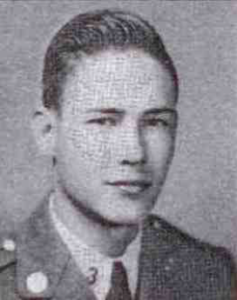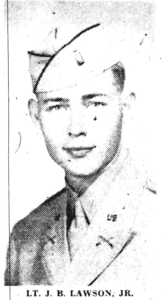Scroll of Honor – J.B. Lawson, Jr.
The Last Christmas
It is fair to say that the Clemson experience of the Class of 1944 was unique. These boys had arrived on  campus in the late summer of 1940, when the United States was at peace. They would leave Clemson College before graduation, their services required by a country engaged in a worldwide conflagration.
campus in the late summer of 1940, when the United States was at peace. They would leave Clemson College before graduation, their services required by a country engaged in a worldwide conflagration.
James B. Lawson, Jr. of Sandy Springs was a member of the Class of 1944 and the son of a member of the Anderson County legislative delegation. He was a mechanical engineering major and a member of the Anderson County Club. With American military might expanding at a dizzying pace, the manpower requirements of the armed services grew and they took precedence over the plans of college students. The War Department determined that Clemson’s rising senior cadets would forgo their final year of college and would be called to active duty upon the conclusion of the 1942-43 academic year.
That summer of 1943, Lawson and most of the other young men in his class traded in their cadet uniforms for the green fatigues of the Army. Lawson first reported to Camp Croft near Spartanburg for basic training. Having demonstrated leadership aptitude, he was next ordered to infantry officer candidate school at Fort Benning, Georgia. Newly minted lieutenants were then sent to one of the many divisions being formed stateside for eventual deployment overseas. Lawson landed with the 290th Infantry Regiment of the 75th Infantry Division, then training at Camp Breckinridge, Kentucky.
By mid-October 1944, the Germans seemed to be reeling. Allied Armies were tightening a vise onGermany from both the east and the west. Rumors began to circulate that Lawson’s 290th Regiment was getting ready for deployment. The rumors appeared to have basis when a detail was formed to prepare water tight containers for the storage of regimental records. Soon after, the regiment began its journey by train. It headed east.
A four-day layover at Camp Shanks, New York allowed time for final checks of clothing and equipment. More than a million men passed through the camp, situated at the juncture of the Erie Railroad and the Hudson River, on the way to Europe. From Camp Shanks, the troops rode the train forty-five min

utes to Weehawken, New Jersey where they boarded the ferry to Staten Island and its piers. Five thousand soldiers squeezed aboard the US Army Transport Brazil for a ten-day voyage to Great Britain, arriving at Swansea, Wales on November 1. From there, it was another train ride to Porthcawl, every mile bringing Lawson and his regiment closer to Europe and the enemy. After five weeks of combat training in Wales, the regiment arrived at Southampton, England. It crossed the English Channel landing at Le Havre, France on December 13 and 14.
And then things got really interesting. Two days later, the Germans launched their greatwinter offensive. Their plan was to mass tanks against the relatively thinly defended American First Army in Belgium, breakthrough Allied lines, divide British and American forces, capture the port of Antwerp, and force the Western Allies to consider a negotiated peace.
With the battle raging and the Germans on the offensive, the 290th on December 19 left its assembly area and began a two-day journey by box car through bitter weather across northern France and Belgium. The regiment arrived at Hasselt, Belgium on December 20 and immediately established its command post—right below the flight path of German buzz bombs heading toward Antwerp.
With German forces threatening to break through the bulge, the 290th decamped from Hasselt shortly after midnight on December 22 heading for the threatened lines of the US First Army. Elements of the regiment were quickly moved into front line positions. 3rd Battalion was ordered to occupy the town of Hotton (about 22 miles northwest of Bastogne)—and hold it at all costs. On the evening of the 24th, Allied forces reclaimed the initiative and the 290th ordered its battalions to attack.
Hill 87 at La Roumière was the objective of Lawson’s platoon. The hill, surrounded by woods, dominated the roads leading to Hotton as well as the Ourthe River which flowed through the town. Lawson’s platoon attacked three times. In one of these attacks, the brave lieutenant was mortally wounded. Lawson’s parents and his fiancée, Miss Van Siclen a former student at Anderson College, received word in mid-January that he was missing in action. Not until February 5 did they learn that he had been killed on December 25, the last Christmas of the war.
Lieutenant James B. Lawson, Jr. was survived by his parents and his three sisters.  He is buried at Sandy Springs United Methodist Church Cemetery.
He is buried at Sandy Springs United Methodist Church Cemetery.
For additional information about James B. Lawson, Jr. see:
https://cualumni.clemson.edu/page.aspx?pid=1737
For more information about Clemson University’s Scroll of Honor visit:
https://cualumni.clemson.edu/scrollofhonor
